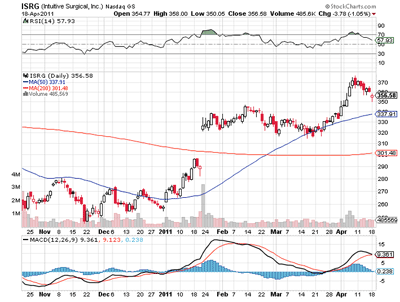See how one trader used an option “collar” as an insurance policy against unforeseen losses in advance of a company’s latest earnings report.
Intuitive Surgical, Inc. (ISRG) was just one of many companies taking the earnings stage this week, with the surgical equipment manufacturer confessing its first-quarter figures on Tuesday, April 19.
According to Thomson Reuters, the analyst crowd was expecting ISRG to record a quarterly profit of $2.49 per share, up about 17.6% from the year-ago quarter.
From an historical standpoint, the company has exceeded analysts' per-share earnings forecasts in each of the past four quarters, but it appears one shareholder locked in an attractive sale price in the event of a post-earnings retreat.
It is an excellent example of how to use an option collar to lock in profits on a position in case reaction to an earnings announcement is negative for the share price.
On Monday, a block of 150 out-of-the-money May 330 puts changed hands for the ask price of $9.47 apiece.
While this purchase alone would guarantee the stakeholder a sale price of $330 per ISRG share, he or she reduced the cost of their portfolio protection by handcuffing the put with out-of-the-money May 380 calls, which the trader sold for $8.77 each.
In other words, the trader constructed a collar on ISRG for a net debit of $0.70 per pair of options.
As with any insurance, the policyholder—the ISRG shareholder, in this instance—isn't hoping for a devastating event, but wants to be protected just in case.
As such, the ultimate goal is still for the shares of ISRG to power higher on the charts. However, while the trader-sold 380-strike calls significantly reduced the initial debit, the trader could now be forced to unload the shares at $380 apiece if ISRG rallies north of the strike by expiration, meaning he or she could miss out on additional upside.
As alluded to earlier, though, should ISRG backpedal beneath the $330 level within the next few weeks, the bought 330-strike puts will allow the trader to sell their shares for $330 each, representing a premium to what they would get on the Street.
From a sentiment standpoint, it seems the Street was a little less leery of ISRG heading into the company's turn in the earnings confessional. According to Zacks, eight out of 15 analysts maintained "buy" or better endorsements prior to the announcement, with the remaining seven offering up lukewarm "hold" opinions.
However, there could be a round of upwardly revised price targets in ISRG's near future, as the stock's average 12-month price target of $347.43—as calculated by Thomson Reuters—represents a discount to the stock's settlement price of $360.36 last Friday.
NEXT: 3 Items to Remember When Initiating a Collar
|pagebreak|Skepticism was also depleting among short sellers. During the past month, short interest fell by about 3.4%, but still accounts for a healthy 4.8% of ISRG's total available float. In fact, at the equity's average pace of trading, it would take more than a week to buy back all of these bearish bets.
After running into a familiar foe in the $370-$380 neighborhood, the shares of ISRG have pulled back to the $350 region. This area acted as a technical ceiling for the stock from May 2010 until earlier this month, and could now switch roles to serve as a foothold for the shares.
Should the firm extend its winning streak in the earnings spotlight, the lingering skepticism surrounding the stock could actually translate into a contrarian boon.
A stronger-than-anticipated earnings report could spark a round of price-target increases or amplify the recent short-covering trend, both of which could serve as catalysts even higher for ISRG.
By the time you read this, you’ll know what the short-term reaction to ISRG’s earnings was. Either way, this trader is protected with their option collar.
In summary:
By Andrea Kramer, contributor, Schaeffer’s Trading Floor Blog




















